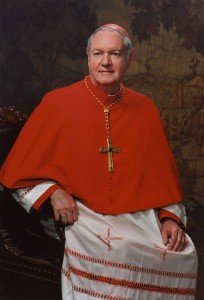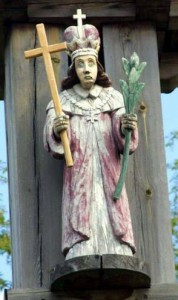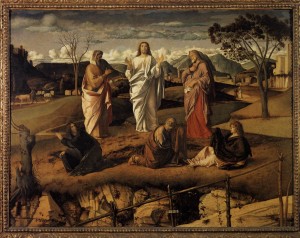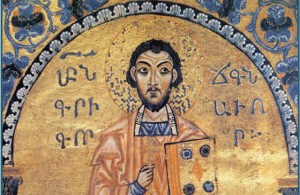|
|
|
|
|
|
 Pope Francis sent a telegram to Cardinal Timothy Dolan, Archbishop of New York on occasion of the death of Cardinal Egan:
Pope Francis sent a telegram to Cardinal Timothy Dolan, Archbishop of New York on occasion of the death of Cardinal Egan:
“Having learned with sadness of the death of Cardinal Edward M. Egan, Archbishop Emeritus of New York, I offer heartfelt condolences to you and to the faithful of the Archdiocese. I join you in commending the late Cardinal’s noble soul to God, the Father of mercies, with gratitude for his years of episcopal ministry among Christ’s flock in Bridgeport and New York, his distinguished service to the Apostolic See, and his expert contribution to the revision of the Church’s law in the years following the Second Vatican Council. To all assembled in Saint Patrick’s Cathedral for the Mass of Christian Burial, and to all those who mourn Cardinal Egan in the sure hope of the Resurrection, I cordially impart my Apostolic Blessing as a pledge of consolation and peace in the Lord.”
FRANCIS PP.
 A short time ago I was notified of the sudden death of Edward Michael Cardinal Egan, emeritus archbishop of New York.
A short time ago I was notified of the sudden death of Edward Michael Cardinal Egan, emeritus archbishop of New York.
Following lunch, he succumbed from a heart attack and was pronounced dead at NYU Medical Center. He would have been 83 on April 2.
Many will say he was brought to NY because his financial abilities. Many will criticize his warmth. He was a kind man who gave others a chance and he looked after the needy. The Holy Father asked him to shepherd the Archdiocese because he had the ability to lead men and women to the Lord.
In 1957 he was ordained priest, in 1985 bishop, by 1988 he was installed as the bishop of Bridgeport and then translated to New York as the 9th archbishop on 19 June 2000. His service to the Church included being given the title of Cardinal on 21 Feb 2001. He retired on 23 February 2009.
I’ve known +EME since 1997 and have always enjoyed his friendship and counsel.
Eternal rest grant unto him O Lord, and let perpetual light shine upon him. May his soul and all the souls of the faithful departed through the mercy of God rest in peace. Amen.
Requiescat in pace et in amore.
 Two saints in a row –Saint Katharine Drexel yesterday and Saint Casimir today–we hear in the opening prayer the theme of holiness and justice. On the surface this is nothing new, nor ought it be surprising. Lent is a time of conversion and a reorientation toward acts of charity. Scripture exhort us to live in this manner, and the saints give good example. How is your orientation toward the universal call to holiness and charity?
Two saints in a row –Saint Katharine Drexel yesterday and Saint Casimir today–we hear in the opening prayer the theme of holiness and justice. On the surface this is nothing new, nor ought it be surprising. Lent is a time of conversion and a reorientation toward acts of charity. Scripture exhort us to live in this manner, and the saints give good example. How is your orientation toward the universal call to holiness and charity?
From the life of Saint Casimir written by an contemporary
By the power of the Holy Spirit, Casimir burned with a sincere and unpretentious love for almighty God that was almost unbelievable in its strength. So rich was his love and so abundantly did it fill his heart, that it flowed out from his inner spirit toward his fellow men. As a result nothing was more pleasant, nothing more desirable for him, than to share his belongings, and even to dedicate and give his entire self to Christ’s poor, to strangers, to the sick, to those in captivity and all who suffer. To widows, orphans and the afflicted, he was not only a guardian and patron but a father, son and brother. One would have to compose a long account to record here all his works of love and dedication for God and for mankind. Indeed, it is difficult to imagine or to express his passion for justice, his exercise of moderation, his gift of prudence, his fundamental spiritual courage and stability, especially in a most permissive age, when men tend to be headstrong and by their very natures inclined to sin.
Daily he urged his father to practice justice throughout his kingdom and in the governance of his people; and whenever anything in the country had been overlooked because of human weakness or simple neglect, he never failed to point it out quietly to the king.
He actively took up the cause of the needy and unfortunate and embraced it as his own; for this reason the people called him the patron of the poor. Though the son of a king and descendant of a noble line, he was never unapproachable in his conversation or dealings with anyone, no matter how humble or obscure.
He always preferred to be counted among the meek and poor of spirit, among those who are promised the kingdom of heaven, rather than among the famous and powerful men of this world. He had no ambition for the power that lies in human rank and he would never accept it from his father. He was afraid the barbs of wealth, which our Lord Jesus Christ spoke of as thorns, would wound his soul, or that he would be contaminated by contact with worldly goods.
Many who acted as his personal servants or secretaries are still alive today; these men, of the highest integrity, who had personal knowledge of his private life, testify that he preserved his chastity to the very end of his life.
 Saint Katharine Drexel (1858 – 1955) was born in Philadelphia to a rich banking family. In 1889, at the age of 33, with the desire burning in her heart, she founded the Sisters of the Blessed Sacrament, dedicated to mission work among Indians and black people. Drexel spent her entire life and her entire fortune to this work, opening schools, founding a university, and funding many chapels, convents and monasteries. Drexel travelled well in the USA.
Saint Katharine Drexel (1858 – 1955) was born in Philadelphia to a rich banking family. In 1889, at the age of 33, with the desire burning in her heart, she founded the Sisters of the Blessed Sacrament, dedicated to mission work among Indians and black people. Drexel spent her entire life and her entire fortune to this work, opening schools, founding a university, and funding many chapels, convents and monasteries. Drexel travelled well in the USA.
She died on 3 March 1955, by which time there were more than 500 Sisters teaching in 63 schools throughout the United States.
“If we wish to serve God and love our neighbor well, we must manifest our joy in the service we render to Him and them. Let us open wide our hearts. It is joy which invites us. Press forward and fear nothing.”
 We are the 2nd Sunday of Lent and the magnificently rich reading from the Gospel of Mark (9:2-10) on the Transfiguration.
We are the 2nd Sunday of Lent and the magnificently rich reading from the Gospel of Mark (9:2-10) on the Transfiguration.
“Jesus took Peter, James, and John and led them up a high mountain apart by themselves. And he was transfigured before them, and his clothes became dazzling white, such as no fuller on earth could bleach them.”
One thing is certain: we can stand looking at the Lord with mouths open; we have to listen to him. Abraham had his vision of God, and listened; Mt. Tabor was the place where Peter, James and John had a unique witness a vision of God. What is your vision of God? What has God said to you today?
Saint Leo the Great reflects:
“The splendor of the Transfiguration clearly and unmistakably reveals the one who had been promised by signs foretelling him under the veil of mystery. As St. John says, ‘The law was given through Moses, grace and truth came through Jesus Christ.’ In him the promise made through the shadows of prophecy stands revealed, along with the full meaning of the precepts of the law. He is the one who teaches the truth of prophecy through his presence, and makes obedience to the commandments possible through grace… When it comes to obeying the commandments or enduring adversity, the words uttered by the Father should also echo in our ears: ‘This is my beloved Son in whom I am well pleased. Listen to him.’”
 Archbishop Stanislav Zvolenský, archbishop of Bratislava, will preside at the ceremony of the closure of the diocesan process of the cause for beatification and sainthood of the Jesuit novice Tomáš Munk and his father František on April 20, 2015.
Archbishop Stanislav Zvolenský, archbishop of Bratislava, will preside at the ceremony of the closure of the diocesan process of the cause for beatification and sainthood of the Jesuit novice Tomáš Munk and his father František on April 20, 2015.
The Family Munk were Jewish converts to Catholicism in 1939. Tomáš entered the novitiate in Ružomberok in 1943. Due to the Nazi ideology against Jewish people, the Munk family were captured by Nazis at the end of 1944. Tomáš was captured in novitiate and later was deported together with his father to the concentration camp Sachsenhausen. Father and son were shot to death during the death march from Sachsenhausen to Berlin on April 20, 1945.
Another good example of holiness in families. I wrote about Tomas in 2009 here at the Communio blog.
There is something very special about Saint Gabriel of Our Lady of Sorrows that we ought to pay attention to today.
Saint Gabriel (1838-1862) was born at Assisi in 1838. He was guided by Our Lady into the Passionist Order founded by Saint Paul of the Cross, and became a veritable Apostle of Her Sorrows. He was a very great and truly contemplative soul, whose only preoccupation was to unite himself to God at all times. He allowed no distractions to enter his spirit, and even though Italy, his country, was in a state of ferment when he entered religion, he wanted to know nothing of it.
The way to attain union with our Savior and our God was, for Saint Gabriel, as for Saint Louis de Montfort, his Heavenly Mother. He wrote home to his father, from the first month of his noviciate, Believe your son, whose heart is speaking by his lips; no, I would not exchange one single quarter of an hour spent near the Most Blessed Virgin Mary, our consolatrix, our protectress and our hope, for a year or several years spent in the diversions and spectacles of the earth. Among his resolutions was that of visiting Jesus in the Most Blessed Sacrament each day, and praying for the gift of a tender and efficacious devotion to His Most Holy Mother. He wrote a beautiful Credo, worthy to be printed in letters of gold, expressing all that he believed of the Mother of God.
At twenty-four years of age Saint Gabriel died of tuberculosis, having already attained heroic sanctity by a life of self-denial and great devotion to our Lord’s Passion and the Compassion of His Mother.
Although his life was without any miraculous event, after his death in 1862 many miracles occurred at his tomb in Isola di Gran Sasso, Italy. He was canonized by Pope Benedict XV in 1920, and his feast was extended to the entire church by Pope Pius XI in 1932. He is the patron of youth, and especially of young religious.
***On leap years, the feast day of this Saint is celebrated on February 28.
Lives of the Saints for Every Day of the Year, edited by Rev. Hugo Hoever, S.O. Cist., Ph.D. (Catholic Book Publishing Co.: New York, 1951-1955)
 It was announced that the famed Father Theodore M. Hesburgh, C.S.C., died at 11:30 p.m. Thursday (February 26, 2015) at Holy Cross House adjacent to the University of Notre Dame. Father Ted was 97.
It was announced that the famed Father Theodore M. Hesburgh, C.S.C., died at 11:30 p.m. Thursday (February 26, 2015) at Holy Cross House adjacent to the University of Notre Dame. Father Ted was 97.
We all know Father Ted as the president of the University of Notre Dame from 1952 to 1987. He was a priest of the Congregation of Holy Cross, and known as a leader in Catholic higher education. Father has been awarded the most honorary doctorates in US history.
“We mourn today a great man and faithful priest who transformed the University of Notre Dame and touched the lives of many,” said Rev. John I. Jenkins, C.S.C., Notre Dame’s current president. “With his leadership, charisma and vision, he turned a relatively small Catholic college known for football into one of the nation’s great institutions for higher learning.
“In his historic service to the nation, the Church and the world, he was a steadfast champion for human rights, the cause of peace and care for the poor.”
Several years ago I had the privilege to meet Father for a good hour of conversation. His eyesight was very poor but he was a great conversationalist. I am grateful for the time we spent talking to in the library named in his honor.
May God be merciful to Father Ted and may he rest in rest from his labors. Our Lady of Sorrows, pray for your son.
 The Catholic Church has a new Doctor –an Armenian saint —Saint Gregory of Narek.
The Catholic Church has a new Doctor –an Armenian saint —Saint Gregory of Narek.
“St. Gregory of Narek is widely revered as one of the greatest figures of medieval Armenian religious thought and literature. Born in the city of Narek in about 950 A.D., St. Gregory came from a line of scholars and churchmen.”
Saint Gregory of Narek’s feast day in the Armenian Church is October 13.
On the occasion of the 1700th anniversary of the Baptism of the Armenian people (2001) Saint John Paul said of Saint Gregory: “Among these illustrious figures, I would like to recall here Gregory of Narek, who probed the dark depths of human desperation and glimpsed the blazing light of grace that shines even there for believers.”
You will note that Saint Gregory, a monk in the Armenian Church, lived at a time when his Church was not formally in communion with Rome and Constantinople. Christian history can be complex to understand.
The Vatican Radio report is here.
The title of “Doctor of the Church” is bestowed on a saint because of his or her contribution to theology or doctrine. There are now 36 Doctors of the Church recognized by the Catholic Church, 4 of whom are women. The Eastern Churches may have a different list for their “Doctors of the Church.”